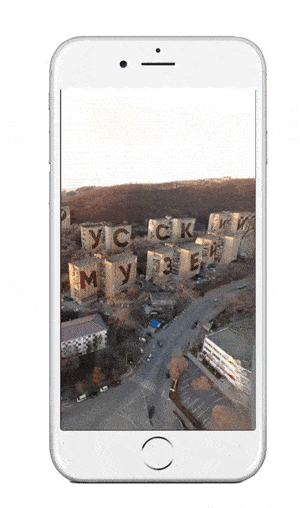WALL_FOR_SCROLL
Project Wall_for_scroll is street art in the form of digital objects in the digital layer of the city. Based on the changes in the concept of public space with the development of digital technologies, the practice intervenes in the advertising field of Instagram, preserving important ethical aspects of street art. «The Markov Chain» algorithm generated text messages based on 5,000 inscriptions from the streets of Russia. A neural network processed the final images. Each digital object is attached to a specific point on the city map, allowing the viewer to inadvertently collect artistic messages by moving around the city.
The project was held from July 6 to 12 in Vladivostok, where it gathered 124,000 views. In St. Petersburg, Wall_for_scroll was available for dating in the public space of Instagram stories from October 15 to 18 and gathered 171,000 views. The project was supported by the ART PROSPECT festival and was presented as augmented reality on the main stage of the festival at the Gaza Culture Center. In 2022, the project became part of the CHO Public Art Festival in Yekaterinburg, ran for a whole month, and was duplicated on the city's advertising video screens. Digitally, the W_F_S had 852,726 views. Twenty digital objects were created for each city.
The project was held from July 6 to 12 in Vladivostok, where it gathered 124,000 views. In St. Petersburg, Wall_for_scroll was available for dating in the public space of Instagram stories from October 15 to 18 and gathered 171,000 views. The project was supported by the ART PROSPECT festival and was presented as augmented reality on the main stage of the festival at the Gaza Culture Center. In 2022, the project became part of the CHO Public Art Festival in Yekaterinburg, ran for a whole month, and was duplicated on the city's advertising video screens. Digitally, the W_F_S had 852,726 views. Twenty digital objects were created for each city.
Wall_for_scroll project is a practice of street art in the digital layer of the city,
implemented in the public advertising space of Instagram
implemented in the public advertising space of Instagram

from July 6 to 12 project was held in Vladivostok, Russia
from October 15 to 18 in In St. Petersburg
from June 6 to July 6 2022 in Yekaterinburg, Russia
from October 15 to 18 in In St. Petersburg
from June 6 to July 6 2022 in Yekaterinburg, Russia
“
The project actualizes the problem of finding a person in a city permeated by a network of relationships, including virtual, invisible, digital ones. Street art remains conventionally unrecognized for art criticism, and the author fills this gap by not only contributing to the subsequent rethinking of the significance of street art in contemporary culture but also by defining its place in the universal digitalization of urban spaces.The author clarifies our idea of public space as a virtual network that helps pedestrian users (or motorists in the case of Vladivostok) navigate through the city and have the power to create communities in the process of their interaction with the city. Thinking about the city as a shared space of time and action is the starting point of the project and a promising position for further research

